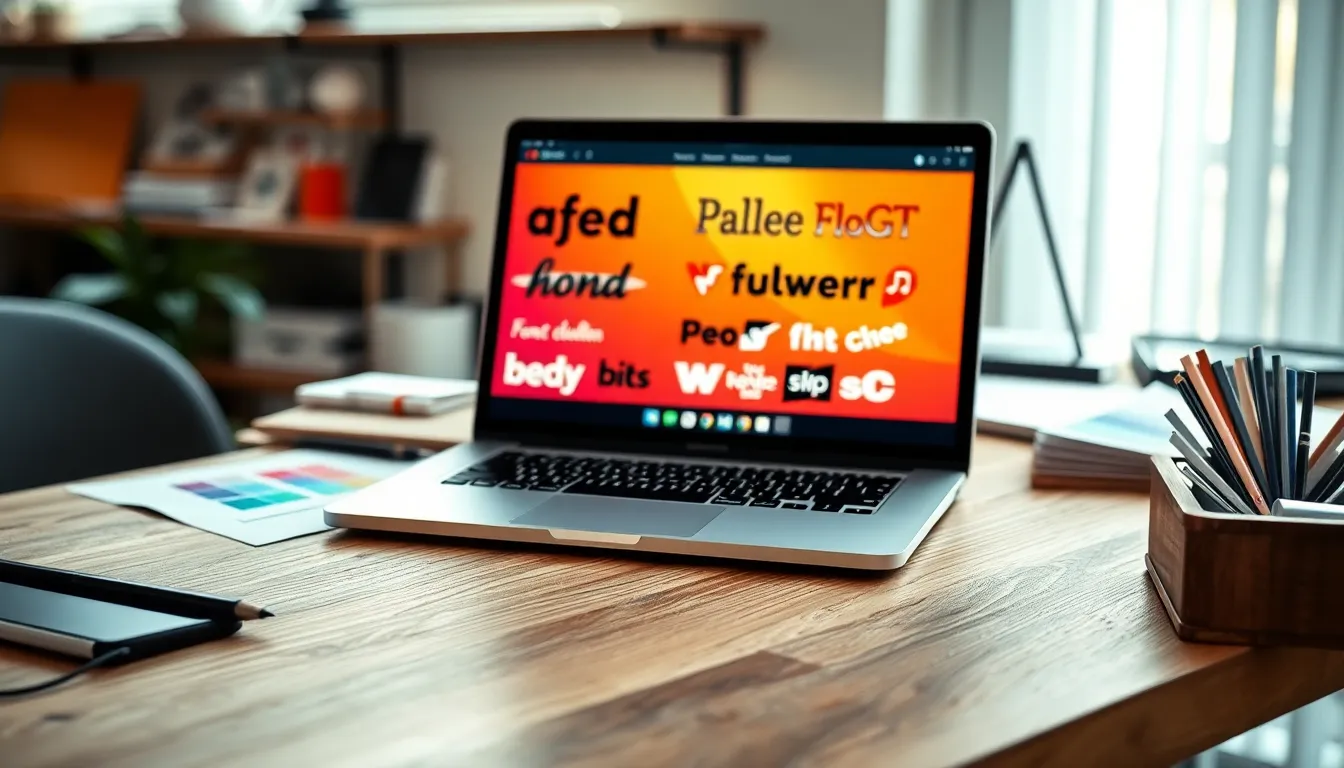Table of Contents
ToggleEver stared at a stunning piece of design and thought, “What font is that?” It’s like spotting a unicorn in a field of horses—rare and magical. Fortunately, technology’s got your back with tools that can identify fonts from images faster than you can say “Helvetica Neue.”
These nifty tools can save designers from the agony of endless font searches. Whether it’s a captivating logo or a quirky poster, knowing the right font can take your project from drab to fab in no time. So, buckle up and get ready to dive into the world of font identification, where each click brings you closer to unlocking your creative potential. Who knew finding the perfect font could be this much fun?
Overview of Identify Font from Image Tool
Identify font from image tools streamline the font recognition process for designers and enthusiasts. Many applications and websites allow users to upload an image containing text. The tool analyzes the image and identifies potential matching fonts from a database.
Several features characterize effective font identification tools. Compatibility with various file formats, such as JPEG and PNG, enhances usability. Accuracy in recognition improves the speed and reliability of results. A user-friendly interface facilitates easy navigation and interaction.
Popular tools include WhatTheFont, Font Squirrel Matcherator, and Adobe Capture. WhatTheFont works by allowing users to upload images or take photos directly. Font Squirrel Matcherator simplifies font searching through its intuitive process. Adobe Capture integrates font recognition into its broader suite of design tools, making it a versatile option.
Accuracy is vital when selecting the right font. Each tool references large font databases to provide reliable match suggestions. Users benefit from advanced algorithms that enhance identification efficiency. Many platforms also offer similar fonts, enabling users to explore alternatives that fit their project’s style.
Feedback and community contributions enhance tool effectiveness. Users can refine results by adjusting parameters such as character spacing and size. Some tools allow for manual adjustments, ensuring optimal accuracy.
Identifying fonts from images not only aids in design but also serves as an educational resource. Users gain insight into font styles and classifications while exploring various design trends. This exploration fosters creativity and ensures designers make informed choices for their projects.
Key Features

Identifying fonts from images involves several key features that enhance the user experience. These features improve the font search process for designers and enthusiasts alike.
Image Upload Options
Image upload options are essential for seamless interaction with font identification tools. Users can upload images in multiple file formats, including JPEG, PNG, and GIF. Some tools even allow users to drag and drop images directly into the interface, simplifying the process. Additionally, mobile applications enable users to take pictures of text in real-time, facilitating immediate font recognition. This flexibility caters to users’ diverse needs, making font identification more accessible.
Font Recognition Accuracy
Font recognition accuracy plays a vital role in identifying the correct fonts. Advanced algorithms analyze uploaded images to match text with extensive font databases, providing reliable results. Many tools utilize machine learning to enhance recognition, allowing for improved accuracy over time. Users often report success rates exceeding 90% when using these technologies. Incorporating community feedback and manual adjustments further refines results, ensuring that users can confidently select the perfect font for their projects.
Popular Tools in the Market
Several tools exist for identifying fonts from images, each with unique features catering to different needs. These tools significantly enhance the font search experience for designers and enthusiasts alike.
Tool 1: WhatTheFont
WhatTheFont excels in delivering accurate font identification. Users upload images and receive matches from a large database. The interface remains intuitive, allowing for seamless navigation. Users appreciate the ability to refine their search by adjusting the image or selecting similar fonts. WhatTheFont also includes community feedback, which enhances the identification process. Extensive compatibility with various file formats, including JPEG and PNG, broadens its accessibility for users across devices.
Tool 2: Font Squirrel Matcherator
Font Squirrel Matcherator provides another robust solution for font identification. This tool allows users to upload images and instantly receive font suggestions. It effectively highlights font styles and categorizes results for easier selection. Matcherator features a user-friendly layout, making navigation straightforward. Users can explore web font options, adding versatility to their projects. The tool utilizes an expansive font database, ensuring accurate identification of numerous typefaces. It also supports manual adjustments, enabling users to refine their font searches accurately.
Benefits of Using Font Identification Tools
Font identification tools streamline the font selection process for designers and art enthusiasts. Users gain invaluable advantages from utilizing these technologies.
Design Efficiency
Designers enhance project efficiency by quickly identifying fonts. Time-consuming searches for specific typefaces diminish with these tools, allowing for faster execution of creative ideas. Immediate results provide access to numerous font matches, which helps in narrowing down options seamlessly. Effortless navigation and user-friendly interfaces contribute significantly to smooth workflow. Designers can focus more on creativity rather than tedious font searches. Tools effectively analyze uploaded images within seconds, ensuring rapid identification. Precision in recognition fosters confidence in choosing the right font, reducing the likelihood of errors.
Creative Flexibility
Creative projects benefit from the versatility offered by font identification tools. Access to a broad range of font options encourages experimentation with various styles and looks. Designers discover unique typefaces that align with their vision, expanding their creative toolkit. Identifying fonts inspires new directions in projects, enabling designers to explore innovative ideas. Tools often showcase multiple font variations, helping users find alternatives that resonate with their desired aesthetic. Immediate feedback on font styles fosters a dynamic design process, allowing for adjustments on the fly. Enhanced creative freedom results from being able to match fonts to specific concepts effortlessly.
Challenges and Limitations
Identifying fonts from images isn’t flawless. Various challenges affect the accuracy of this process. Low-resolution images lead to difficulty in recognizing fonts accurately. Complex backgrounds often interfere with detection, resulting in erroneous suggestions.
Limited databases may hinder results. Some tools depend on specific font collections, which can exclude niche or newly released fonts. Users might encounter scenarios where the desired font isn’t present in the tool’s library. Additionally, common fonts can produce redundant results, making it harder to find unique options.
Certain tools struggle with intricate typefaces. Fonts featuring decorative elements or unusual patterns may not be correctly identified, leaving users unsatisfied. Users should be aware that handwritten or stylized scripts often elude automated recognition.
Intuitive user interfaces can minimize frustration. Yet, confusion can arise if the tool provides too many similar font options. Overwhelming users with choices detracts from the intended efficiency of the font identification process.
Accuracy isn’t guaranteed. While many tools boast success rates exceeding 90%, they can still miss the mark. Users may find that human judgment complements automated results effectively.
Technical limitations exist as well. Internet connectivity issues can interrupt the functionality of web-based tools. Mobile applications may face compatibility challenges with specific devices, affecting usability.
Successfully identifying fonts depends on various factors, including image quality, complexity, and the tool’s database. Understanding these challenges prepares users for a more effective font identification journey.
Exploring the world of font identification tools opens up new avenues for creativity and efficiency. Designers and enthusiasts alike can benefit from the ability to quickly and accurately identify fonts from images. These tools not only streamline the font selection process but also inspire innovative design choices.
While challenges exist in recognizing certain styles or dealing with low-resolution images, the advantages far outweigh the drawbacks. With a range of options available, users can find the right tool that fits their needs. Embracing these technologies enhances the creative journey and ensures that the perfect font is just a click away.








